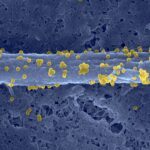Lien vers Pubmed [PMID] – 22761958
PLoS ONE 2012;7(6):e40194
Human endogenous retroviruses (HERVs) are spread throughout the genome and their long terminal repeats (LTRs) constitute a wide collection of putative regulatory sequences. Phylogenetic similarities and the profusion of integration sites, two inherent characteristics of transposable elements, make it difficult to study individual locus expression in a large-scale approach, and historically apart from some placental and testis-regulated elements, it was generally accepted that HERVs are silent due to epigenetic control. Herein, we have introduced a generic method aiming to optimally characterize individual loci associated with 25-mer probes by minimizing cross-hybridization risks. We therefore set up a microarray dedicated to a collection of 5,573 HERVs that can reasonably be assigned to a unique genomic position. We obtained a first view of the HERV transcriptome by using a composite panel of 40 normal and 39 tumor samples. The experiment showed that almost one third of the HERV repertoire is indeed transcribed. The HERV transcriptome follows tropism rules, is sensitive to the state of differentiation and, unexpectedly, seems not to correlate with the age of the HERV families. The probeset definition within the U3 and U5 regions was used to assign a function to some LTRs (i.e. promoter or polyA) and revealed that (i) autonomous active LTRs are broadly subjected to operational determinism (ii) the cellular gene density is substantially higher in the surrounding environment of active LTRs compared to silent LTRs and (iii) the configuration of neighboring cellular genes differs between active and silent LTRs, showing an approximately 8 kb zone upstream of promoter LTRs characterized by a drastic reduction in sense cellular genes. These gathered observations are discussed in terms of virus/host adaptive strategies, and together with the methods and tools developed for this purpose, this work paves the way for further HERV transcriptome projects.

